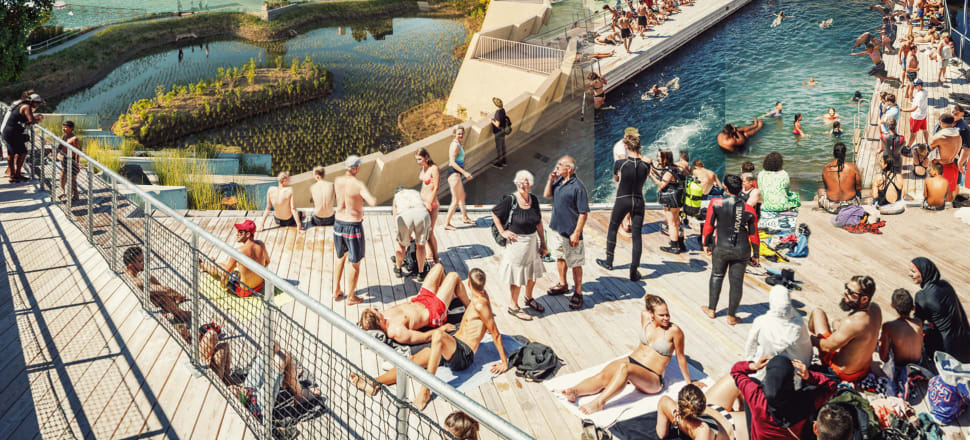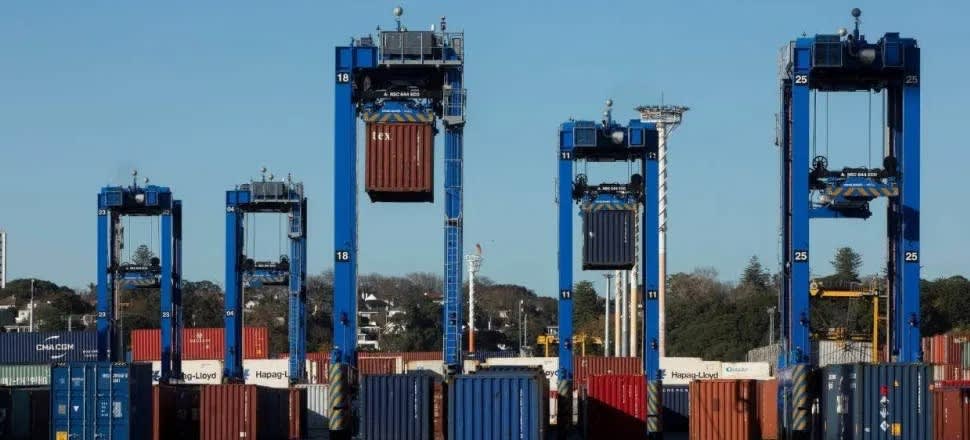
Lack of productivity was an issue in the past, but Ports of Auckland expects to continue to exceed its forecasts
Just hours after news broke over Auckland Council’s grand plans for the waterfront, Ports of Auckland’s top dog revealed cargo volumes had begun falling away.
The keynote speaker at a Trans-Tasman Business Council event this morning, the port's chief executive Roger Gray said trade volumes had fallen by about 30 percent in the last quarter.
Poor returns from the port, which sits on some of the most valuable land in New Zealand, have been a major part of the drive to either shift the port or shrink its footprint, but Gray expects profits and returns to council to continue to rise despite the drop.
READ MORE: * Ports of Auckland fighting to secure its future * Shipping congestion will ease once recession hits * E-commerce dropping away ‘markedly’
He said the drop-off in volumes was mostly in container imports.
“We speak to retailers, they're saying to us particularly they have excess inventory from the just-in-case model that they set up and off the back of now the freeing up of supply chain and certainty coming back into the reliability of calls, berth windows etc, that they are now transitioning back to just in time [as opposed to just in case].”
Gray said these companies were driving down working capital, with a number of retailers telling the port they intended to run down the stock they had before ordering more, as opposed to the lockdown disruption era approach of bringing in as much stock as possible.
It’s a logical approach in the current economic environment where discretionary spend is suffering, but perhaps an unwanted one for a business trying to supercharge its profits to show it's worth the $1.5b tied up in it to a mayor who actively campaigned on shifting the port’s operations.
It also times up with a freer-flowing port environment that won’t be able to collect the same level of demurrage charges for lingering containers, expected to reduce by a combined $75m across all of New Zealand’s ports.
Guidance
The port is still finalising its results for the 12 months ending June 30, but Gray said the port was going to exceed its earlier profit guidance of between $42m and $45m for the 2023 financial year.
That earlier guidance was already well above the 2023 profit goal of $35m laid out in its most previous statement of corporate intent.
Gray is still confident the port will exceed its 2024 goal of $52m, and increase its profits to $70m by 2026. Seventy million dollars is equal to a 6.6 percent return on equity.
There would likely be a Christmas rush later this year, but he said it was unclear when things would pick back up.

“Even with the soft container stuff, we're seeing really strong return of cruise, probably the highest cruise volume we've ever had this coming year, still strong roll-on roll-off and still strong bulk cargo.
“It's not easy, but we think we can do it and we have also signalled to the market a further step change in our access charge regime and lifting access charges from January.”
New Zealand’s ports have some of the lowest access charges globally.
Gray acknowledges businesses don’t like cost prices but said most were understanding when the facts were laid out.
“Until we're making our weighted average cost of capital as a return, there's no incentive to further invest back in the infrastructure for the future so we simply just have got to do it. And actually, when you sit down and have that conversation with people, they do accept that.”
Brown’s plan
Yesterday it was revealed Auckland Council has begun considering the first stage of redevelopment of the waterfront including port land.
The initial redevelopment work will focus on the wharves including Queens Wharf, Captain Cook, Marsden and Hobson Wharf extensions.
Mayor Wayne Brown said the port’s roll-on roll-off car import area on Bledisloe Wharf would follow in the not-too-distant future.
According to a render provided by council, options for the area include wetlands, public pools and waka ama facilities. Contamination and lack of power and sewerage infrastructure could rule out or discourage more intensive development on the land.
Brown said the work indicated a pathway to return a portion of land back to public use within the next two to five years without undermining the port’s operations.
“As far as the port operation goes, we are just following on from the work commenced by the previous mayor and council and I think it is worthy of consideration.
“I am still opened minded about the best solution and am genuinely interested in hearing what councillors, the Maritime Union and users of the port and Aucklanders think about it.”
There is a wider review taking place of the port business, but the process is being kept tightly under wraps.
Conversation moved
Gray said the council’s announcement yesterday didn’t take him by surprise as the company had been working with the council on its reviews for some time.
“The conversation has moved on from moving the cars to a conversation about how do we maintain the operations of the port whilst being able to hand back some land.
“There is an acknowledgement and understanding both from the mayor's office and also the governing body and the consultants of the importance of each of their [port operation's] respective traits and how they contribute to the overall result.”
He said the Cook and Marsden wharves could be handed back in the desired time period subject to the construction of a new berth on the northern end of Bledisloe Wharf to pick up any slack.
Previous plans to build an extension to that wharf have failed to eventuate, but perhaps the port’s added political capital in this situation could get that across the line, but Gray denies it being a bluffing game.
“It's more just it's just a statement of fact and reality if you want to preserve the businesses.
Material impact
“If there's a faster transition off land, the risk you face is that one of the trades is displaced and is moved and what that then does is has a material impact on the profitability of the port and the material impact on the dividend that we'd be providing to the city.”
The council is of course keen to wrap Bledisloe Wharf into the redevelopment “in the not-too-distant future”.
Gray said activity would naturally move east across the port towards the Fergusson Container Terminal as trades, such as the importation of coal, slow or condense.
“The debate around Bledisloe's transition is not about if, the debate is about when and the timing and I think there's a difference of views.”
The board and management aren’t completely at the behest of the council, with the Port Companies Act requiring they act in the best commercial interest of the port, not its owners.
“The shareholders are well aware of that, we've talked at length with them about that. I think we can find a solution that satisfies both the aspirations of whatever the governing body decides and the obligations the board and management have.”







